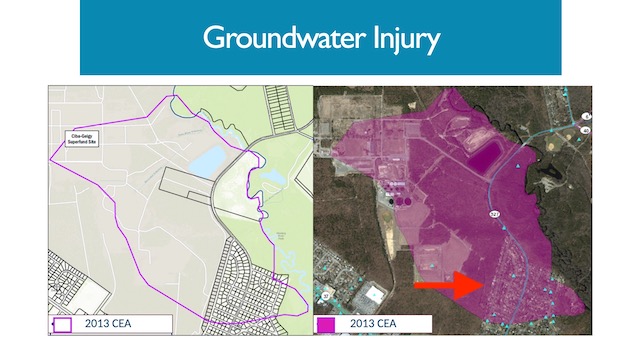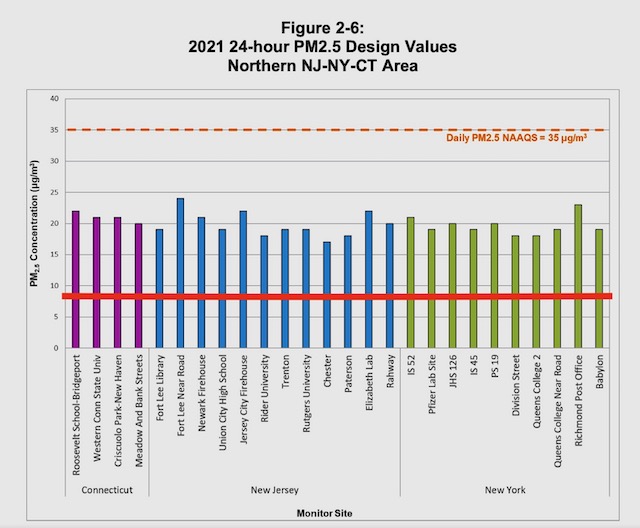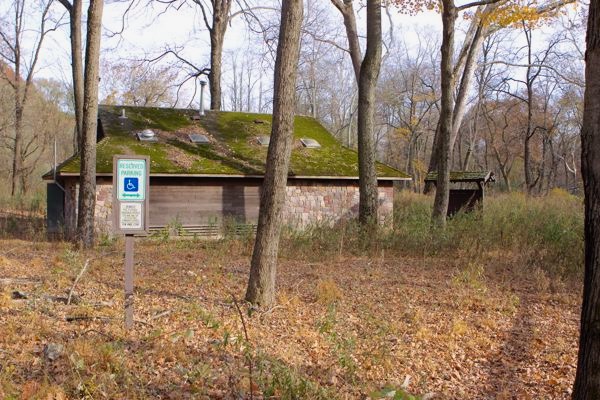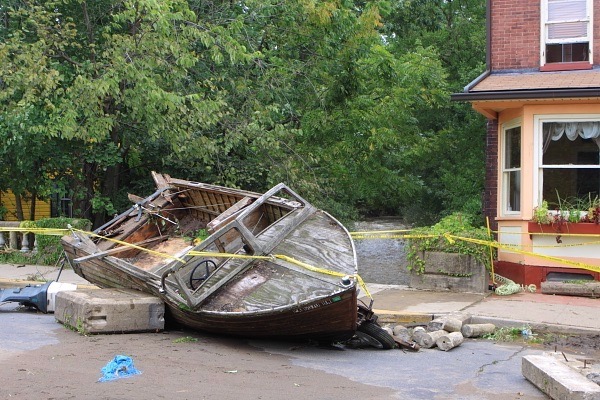
Source: NJ DEP briefing to environmental groups (12/2/22) – red arrow mine
Murphy DEP Commissioner LaTourette is a former corporate lawyer who litigated and won an NRD case representing a NJ chemical company known as Essex Chemical, a subsidiary of Dow chemical. He knows the legal and scientific weaknesses of DEP’s NRD program, yet has done nothing to correct, reform and strengthen them.
Below is an outline and bullet points of the 10 top reasons why DEP’s proposed settlement with BASF for natural resource damages at the Ciba-Geigy Toms River Superfund site is flawed and must be withdrawn.
I need to do additional research to document each point. I encourage others with knowledge and expertise to conduct their own research and I would be glad to receive support and post that information here.
Here is a link to the draft Settlement.
Here is a link to DEP’s Office Of Natural Resource Restoration webpage.
The public comment period closes on February 3, 2022 – people can submit comments to DEP at this email address: onrr@dep.nj.gov
I) The Settlement Surrenders And Lacks Important Legal And Financial Protections
For context and to illustrate omissions and flaws in the DEP BASF settlement, compare it to a recent NRD Settlement between the US Department of Justice and BASF at the Passaic River Superfund site.
Note that the US DoJ settlement is based on a structured, transparent, public, and science based process for NRD damage assessment, recovery and restoration planning and design.
DEP has none of that.
Note that the USDOJ settlement is partial and not final. Note how it estimates the value of the settlement ($73.5 million for a 5 acre park). It also anticipates a future science based natural resource injury final Report as the basis for additional compensation and restoration requirements.
Note the USDOJ BASF settlement requires a $1 million escrow account for 30 years of maintenance of a 5 acre park. The costs for maintaining a 1,400 park could be far higher at BASF site, with millions more for science, public education and various environmental data collection and monitoring. Yet there are inadequate escrow and mandatory obligations, and they should run for far more than 30 years – at least until all pollution is cleaned up.
DEP would provide BASF with a blanket covenant not to sue, in perpetuity (See also Appendix A):
8. The Department fully and forever releases, covenants not to sue, and not to otherwise take administrative action against BASF and its corporate officers, directors, employees, predecessors, parents, successors, and subsidiaries, for any and all of the Department’s causes of actions for Natural Resource Damages arising from discharges at or from the Site.
This lets BASF completely off the hook and is reckless, given uncertainties, lack of data on actual natural resource injuries or their economic value, regional impacts, and future conditions and unknowns.
DEP admits this kind of uncertainty and future unknowns in the draft settlement document itself – and amazingly allows BASF to determine the economic value of NR injuries in the event that something goes wrong:
23. d –
iv. If within 90 days the Department determines in its sole discretion that on-site institutional and (as deemed necessary) engineering controls cannot be implemented and that a new project cannot be performed on-site, BASF shall identify additional off-site NRD projects acceptable to the Department;
v. If after additional 90 days the Department determines in its sole discretion that a project cannot be performed on-site or off-site, BASF will satisfy its NRD liability for this particular project(s) area by a lump sum payment in the amount for the cost of the project(s) which shall be established by BASF and reviewed and approved by the Department.
There are inadequate obligations to guarantee long term funding for Operations and Maintenance, and for funding the monitoring and science projects outlined in the settlement.
There are no prohibitions or restrictions on BASF using the settlement for corporate tax breaks. With the sale of land for development and tax breaks, BASF could possibly profit from this settlement.
II) DEP Failed To Document, Assess, And Estimate The Economic Value Of Natural Resource Injuries
I submitted an OPRA public records request for DEP documents that document, assess, and quantify the natural resource injuries and estimate the economic value of natural resource injuries, including the “Baseline Ecological Assessment” that is required under the DEP’s toxic site cleanup program regulations.
DEP was forced to admit that they had none.
Without quantifying the natural resource injuries and their economic value, DEP was flying blind in negotiations with BASF.
With no documented estimate of the extent of natural resource injuries or the value of the damage – including lost use of these resources – the public has no way of knowing if DEP secured adequate compensation and restoration and whether deal is in the public interest, or another pennies on the dollar corporate giveaway.
III) DEP Is Using the NRD Settlement To Weaken Cleanup Standards And Promote Development
The DEP did not require BASF to preserve the entire 1,400 acre tract.
The settlement divides the tract into three parcels, one of which will be sold for development.
17. …. The Preservation Acreage will be protected through the recording of
three Deed of Conservation Restriction (DCR): (1) one for approximately 535 acres (DCR Settlement Area 1 or Forested Parcel) as described in Schedule A; (2) one for approximately 255 acres (DCR Settlement Area 2 or Project Parcel) as described in Schedule B; and (3) one for approximately 210 acres that will be retained by BASF indefinitely (DCR Settlement Area 3 or Retained Parcel) as described in Schedule C.
Local officials have blasted BASF for challenging local property taxes on the basis that the land was undevelopable, and now DEP will allow them to profit even more.
The DEP would allow relaxed cleanup standards on that tract.
19. A licensed site remediation professional (LSRP) will evaluate the results of the sampling program referenced in Section 23.d. to confirm, subject to provisions in Section 23.d, that sampling results within surface soil (0 to 2-feet below ground surface) meet the Department’s residential soil remediation standards within DCR Areas 1 and 2. The LSRP will also evaluate the results to confirm that the soil sampling results for DCR Area 3, within surface soil, meet the Alternative Remediation Standards approved by the Department (Approved ARS) for DCR Area 3 and are therefore protective of restricted use of the adult maintenance worker.
This section requires additional research and writing.
IV) Significant Natural Resource Injuries Were Ignored
Based on the DEP presentation to environmental groups, it seems like DEP is asserting groundwater injury as the only NRD injury that must be considered and compensated for.
DEP NRD lawsuits assert a broad array of natural resource injuries.
Ciba-Geigy’s discharges of hazardous chemicals was regional in scope: the ocean, fisheries, Toms River, and the inland coastal aquifers, surface waters, wetlands, forests, fish, wildlife and aquatic biota all were impacted and injured.
There is no evidence I could find that suggests that these injuries were assessed, quantified and recovered and/or will be restored.
In fact, the draft settlement itself claims that specific studies cited in the settlement – which are remedial cleanup documents and do NOT include NRD assessment documents – adequately provide a basis for the settlement:
10. The Department finds that the information provided in the reports referenced in the paragraphs above is sufficient to form a rational basis for determining the nature and extent of natural resource injuries arising from the discharges and for determining the nature and extent of BASF’s alleged liability for Natural Resource Damages, defined below, arising from the discharges at the Contaminated Site.
[11.]
12. Contingent upon BASF’s completion of the NRD Settlement Project together with payment to the Department in accordance with paragraph 18 of this Settlement Agreement, the Department finds and agrees, that the value of the NRD Settlement Project provided in this Settlement Agreement will offset the injuries to natural resources caused by the discharges of hazardous substances. The Department therefore finds and agrees, subject to these contingencies, that the value of the compensation provided in this Settlement Agreement constitutes BASF’s fair share of Natural Resource Damages addressed in this Settlement Agreement.
This is unacceptable. DEP made these finding without quantifying the value of the actual damage. Or even the value of the land BASF will preserve.
This section requires additional research and writing.
V) Common Law Doctrines of Trespass And Public Nuisance Are Absent
Claims involving Common Law Doctrines of Trespass And Public Nuisance are included in all DEP NRD lawsuits.
But I could find no evidence that Trespass and public nuisance were incorporated in the settlement.
I can think of no greater “trespass” than off-site migration of toxic chemicals that poison and force shut down of public water supplies and individual homeowner wells, or threaten vapor intrusion into people’s homes. (see the red arrow above to note how the groundwater plume is under people’s homes).
The draft settlement claims that public issues were addressed, but did this analysis include vapor intrusion? In March 2001, DEP was still ignoring vapor intrusion risks and had not yet incorporated vapor intrusion into the DEP cleanup program:
8. In March 2001, the State of New Jersey completed a Public Health Assessment that, among other things, determined that ground water at the Contaminated Site was contained, and that other public health exposure pathways had been interrupted.
There were historic discharge of billons of gallons of chemical wastewater, surface runoff, and migration of contaminated groundwater to the ocean and the Toms River.
VI) Groundwater Injury Was Narrowly Defined And Not Quantified
Is there a comprehensive inventory and cost estimate of all the public and private money spent over the last 40 years to respond to Ciba- Geigy’s pollution impacts on public water supply systems and private drinking water wells? Those are all NRD injuries that must be compensated.
In this Spotlight interview, former corporate lawyer DEP Commissioner LaTourette emphasized the need to hold corporate polluters accountable and make them pay to cleanup NJ’s drinking water (starting at time 2:33 – emphasis mine):
[treatment technology] has a cost, a cost that the water systems and the residents of NJ should not pay. Because the cost of curing what has befallen our water in NJ should be borne by those who caused it. The companies that put this material into the stream of commerce in the first place.
Where in this draft settlement has BASF compensated the public for these costs?
All DEP NRD lawsuits include extensive and broad claims about the importance of groundwater, in terms of public water supply as well as a result of inter-connections with surface water and wetlands. There are ecological injuries resulting from those inter-connections and also physical impacts like salt water intrusion and land subsidence.
This would include the impacts and injuries of poisoning billions of gallons of groundwater, plus the effects and injuries caused by pumping and treating and discharging billions of gallons of water. The impacts are significant and regional in scope.
I could find no evidence that the DEP considered the full scope of these injuries and their is no way to know how these injuries were considered and factored into the settlement.
VII) The Restoration Plan Is Low Cost, Underfunded, And Deceptive
I will do an individual post of the restoration plan and long term science, monitoring and maintenance issues.
But let me note here that DEP’s 12/2/22 power point presentation of it to environmental groups relies on deceptive visual manipulations, like posting side by side photos and artist renditions of a fall/winter brown landscape with an artist’s rendition of a green spring/summer landscape.
There also could be public health risks of access to the site. DEP has required studies (which are superficial PA/SI screening methods and totally inadequate), so this shows that there are still unknowns.
VIII) DEP Failed To Learn From Prior Mistakes And Legal Defeats
The DEP NRD program has suffered from a lack of science based regulations and methods to quantify natural resource injuries. NJ Courts repeatedly have rejected NJ DEP NRD lawsuits on this basis.
1. A prime example of that was when DEP had a weak legal hand and cut a very bad deal in the notorious Exxon settlement, where DEP settled for just $225 million on an $8.9 BILLION damage claim (less than 3 cents on the dollar) –
As we exposed at the time, read the NJ Law Journal’s excellent analysis of that fiasco:
… some lawyers and environmental advocates said the state’s failure to adopt a methodology for calculating damages for harm to natural resources through the formal rule-making process—as it committed to do more than a decade ago when it settled another suit—weakened its negotiating position and led to a lower settlement in not just the Exxon case but in other natural resource damage suits it has brought. […]
Wolfe said the lack of valuation rules leaves the state vulnerable to challenges on the amount of damages.
The state “knows it has a weak legal hand,” making it reluctant to push too hard and more willing to settle, Wolfe said.
Exxon’s lawyers are “sharp enough to know this” and to assume the state knows it is legally vulnerable, Wolfe said.
“There’s this wink and a nod going on where the DEP is saying, ‘We won’t squeeze you too hard if you just come to the table and settle,’” Wolfe said.
It’s been “a quiet little dance for 10 years,” with the state knowing it can’t get more than pennies on the dollar”, Wolfe said.
2. DEP previously got burned by accepting toxic contaminated land as compensation in a Dupont NRD settlement. The settlement was so bad that DEP had to re-open and re-litigate it.
As we exposed, read the Bergen Record’s excellent disclosure of that fiasco:
“Bill Wolfe of the Public Employees for Environmental Responsibility’s New Jersey chapter agreed. “DuPont got a sweetheart deal and DEP didn’t do their homework,” Wolfe said. “The deal must be renegotiated and DuPont forced to pay fair compensation, especially to Pompton Lakes residents who have suffered for decades.”
3. NJ Courts have rejected DEP NRD claims and ruled in favor of corporate polluters in several prior cases. Despite these legal loses, DEP has failed to rectify the legal, scientific and regulatory flaws that the Courts have found d in DEP’s NRD program.
See this NJ PEER Report I wrote on those cases, way back in 2007:
Trenton — In a stunning legal setback, the State of New Jersey cannot recover damages from polluters in what may be thousands of contaminated groundwater cases, according to Public Employees for Environmental Responsibility (PEER). The problem stems from the state’s failure to adopt regulations governing how to calculate “natural resources damages” (NRD) for polluted drinking water.[…]
“This regulatory train wreck was completely preventable,” stated New Jersey PEER Director Bill Wolfe, a former DEP analyst, pointing to repeated acknowledgements by state officials of the need to act:
- In 2002 “Vulnerability Assessments,” DEP estimated that as many as 4,600 cases may require NRD litigation which would necessitate both rule making and extending the statute of limitations. This data prompted former DEP Commissioner Bradley Campbell to say he was “astounded to find on taking office in [2002] that the [DEP] had not pursued, or left unsettled, thousands of cases against polluters responsible for a wide range of damages to New Jersey’s natural resources,” pledging to put the program “back on track”;
- In a 2004 settlement agreement of the case New Jersey Society of Environmental & Economic Development (SEED) v. Campbell (N.J. Super. Law Div., Mercer County) DEP legally committed to propose formal natural resource damage regulations; and
- At a May 24, 2005 seminar at Rutgers’ Cook College, John Sacco, Chief of DEP’s Office of Natural Resource Restoration pledged that natural resource damage regulations will “hopefully” be proposed in fall 2005. But since then, there has been no apparent activity to move rules forward.
“The corporations who had the most at stake stalled the NRD program during the Whitman administration but failed to kill it outright. Now, through inaction, the Corzine administration has provided polluters precisely the relief they sought,” Wolfe added. “Those officials responsible for these policies and blocking these regulations should be identified and drummed out of public service.”
The BASF deal replicates all these errors.
IX) The Process Appears Corrupt
This section requires additional research and writing.
Negotiation of the settlement of a lawsuit is a confidential legal process, but that does not prohibit DEP from conducting a parallel process to meet with and gauge the community’s needs and expectations for compensation, restoration, and reuse of the site. DEP failed to do this and instead blindsided the community.
The DEP lawsuit was filed back in 2007. DEP claims that BASF approached the State seeking a settlement in 2010. DEP says they began negotiations of this deal in 2019. So, this is a Murphy administration deal.
But what was the legal process over those 15 years? Did the DEP/AG aggressively prosecute the case? If not, then DEP signaled retreat a long time ago.
Did courts make any findings? We need help from the legal eagles out there!
DEP’s December 2, 2022 briefing of environmental groups was designed to generate public support for this deal and mislead the public. That was an inappropriate meeting.
Commissioner LaTourette is a former corporate lawyer who litigated and won an NRD case for a NJ chemical company known as Essex Chemical that is a subsidiary of Dow chemical. He knows the legal and scientific weaknesses of DEP’s NRD program, yet has done nothing to correct, reform and strengthen them.
There is a lot of evidence in the public record that suggests that Gov. Murphy had extensive high level and close personal and corporate relationships with BASF based on his prior role as US Ambassador to Germany during the Obama Administration and in his prior finance career at Goldman’s Sachs. He has appeared at international events involving BASF. Murphy has gone out of his way to publicly praised BASF and he voiced strong support for BASF, including providing more corporate subsidies.

Phil and Tammy and and their German Corporate Friends
Here is an example, from the Global Bridges Forum:
Governor-Elect Murphy will market international corporate/investors for Foreign Direct Investments (FDI) in his state, specifically from Germany and Israel. There is already significant German investment in NJ (BASF etc.), however Murphy feels more can be done.
BASF is a German corporation and their North American HQ is in New Jersey.
This all suggests the possibility of political influence and Gov. Murphy’s personal intervention. See another possible example here:
This section requires additional research and writing.
X) The Deal Creates A Reasonable Appearance Of Undue Industry influence On DEP
This section requires additional research and writing.
NJ’s ethics laws are based on an “appearance” standard.
Here is Gov. Murphy’s wife at a recent BASF NRD deal in East Newark: Not a good look:

Source: BASF press release





